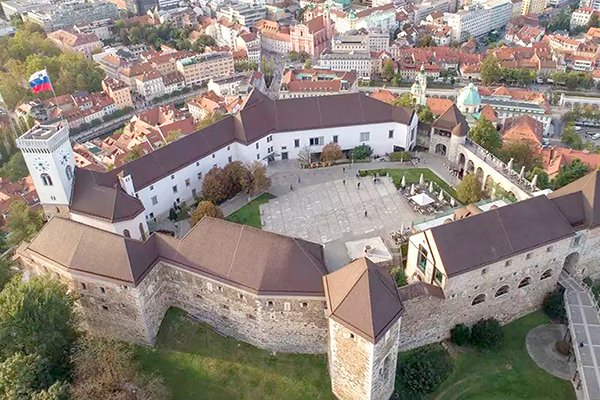With Been Named As Europe’s Green Capital, And There Are Year-Round Festivities To Celebrate – We’ve Every Reason Why
You Need To Explore Ljubljana. So, Start Taking Notes.
There’s no denying that Ljubljana is one of Europe’s prettiest capitals. And in this issue, we are decoding its atmospheric web of cobbled streets with pastel-coloured buildings topped with terracotta tiled roofs.
The Slovenian capital of Ljubljana echoes so many other cities. With chocolate box pretty medieval streets up there with Prague, grand townhouses that would charm the Viennese, remarkable Italianate churches and some of the finest art nouveau you will set eyes on. Some of the city’s buildings are Baroque and others Viennese Secession style.
Whoever you would want to believe, but this is a city with a fascinating history. You can get a crash course in its past at the City Museum, or for an insight into more recent history try the National Museum of Contemporary History. So, let’s get into the itsy-bitsy deets and plan your trip together.
LJUBLJANA CASTLE

Ljubljana Castle is standing on a hill above the city for about 900 years, and is the place’s main attraction with numerous internationally recognized sustainability certifications. The castle’s outlook tower and ramparts offer some of the most beautiful views of the city, while the castle houses a museum exhibition on Slovenian history, a puppet museum, and a number of historical rooms such as the Chapel of St George, the Prison, and a video presentation room called Virtual Castle.
Perched atop a hill and surrounded by trees, Ljubljana Castle is one of the city’s main tourist attractions. While archaeological surveys indicating that the mount has remarkably been in continuous use since at least 1200 BC, the castle itself was built in the 11th century, with most of its buildings and fortifications now dating to later centuries. As such, there are lots of different architectural styles on show.
DRAGON BRIDGE
The Dragon Bridge, adorned with famous dragon statues, appeared in the most recognizable images of Ljubljana. If you haven’t been photographed next to a Dragon Bridge dragon, you can hardly claim that you have visited Ljubljana. Art Nouveau-style Dragon Bridge, dedicated to the symbol of the city – the dragon and one of the most famous of Ljubjana’s landmarks.
Keep your eye out for more dragons too, there are metal dragon sculptures dotted around the city. The four dragon statues, which look slightly terrifying and almost real (if, of course, you believe that dragons might be real), which has been exciting
imagination since the bridge was built.
Constructed between 1900 and 1901, it was Ljubljana’s first reinforced concrete structure and one of the largest bridges of its kind to be built in Europe.
CITY MUSEUM OF LJUBLJANA
If you visit to the City Museum of Ljubljana, you can admire the Renaissance architectural features of the palatial museum building, as the museum is situated in Auersperg Palace, which in itself is an architectural monument.
The museum holds Ljubljana’s cultural heritage that ranges from the 4,500-year-old prehistoric pile dwelling settlement to the present-day charming capital of Slovenia. Its collection comprises over 200,000 museum objects accounting for several millennia of the Ljubljana region’s heritage. The museum is especially proud of the two findings, the world’s oldest wooden wheel with a wooden axle and a wooden point around 40,000 years old.
To round off the tour of the four-storey museum building, visitors can stop at the museum café for refreshment or at the museum shop to buy a souvenir.
THE CATHEDRAL (CHURCH OF ST NICHOLAS)
Ljubljana Cathedral, also named St. Nicholas’ Cathedral, was originally a Gothic church. In the early 18th century, it was replaced by a Baroque building. It is an easily recognizable landmark of the city with its green dome and twin towers and stands at Cyril and Methodius Square by the nearby Ljubljana Central Market and Town Hall.
The site was originally occupied by an aisled three-nave Romanesque church, the oldest mention of which dates from 1262. An
extensive fire in 1361 saw it refurbished in the Gothic style but underwent alterations when the Diocese of Ljubljana was established in 1461 and the church became a cathedral. The construction took place between 1701 and 1706. The first worship
took place in the new building in August 1706, and the consecration took place on 8 May 1707. Originally, a fake dome was painted on the arch above the centre until the church’s real dome was constructed in 1841.
NATIONAL GALLERY OF SLOVENIA
The National Gallery, Slovenia’s foremost museum of historical art, holds the country’s largest collection of fine art from the High Middle Ages to the 20th century. It also houses a permanent exhibition of works by Zoran Muši? (1909–2005), one of Europe’s leading modernist painters, and various temporary exhibitions.
The National Gallery’s permanent collection, divided into sections according to historical periods, and is comprised of nearly 600 works by Slovenian and European artists. With one of the largest pieces of Baroque art in Ljubljana, the Fountain of Three Carniolan Rivers by Francesco Robba, whose original site in front of the Town Hall, the gallery is now occupied by its replica.
